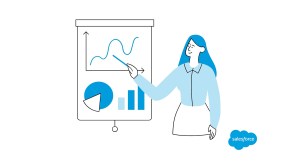Performance analytics is the process of collecting, analysing, and visualising data to gain insights into the performance of a business or organisation. It enables organisations to identify strengths, weaknesses, and opportunities for improvement. By leveraging performance analytics, businesses can make informed decisions and strategies to optimise their operations and achieve better outcomes.
In this blog post, we will explore the concept of performance analytics, its significance, and how it works. We will also discuss various examples of how performance analytics is used across different industries, the benefits and challenges associated with its implementation, and the role of key performance indicators (KPIs) in performance analytics. Additionally, we will draw a distinction between performance analytics and performance appraisals and delve into the integration of performance analytics with Salesforce.
What is performance analytics?
Within business and organisational success, performance analytics stands as a beacon of data-driven insights. It’s the systematic process of gathering, analysing, and presenting data to gain a profound understanding of how a business, organisation, or individual is performing. This powerful tool enables the identification of trends, patterns, and areas that demand improvement.
Equipped with performance analytics, businesses can meticulously assess the effectiveness of their marketing campaigns, sales strategies, and various initiatives. This empowers them to allocate resources wisely, ensuring maximum return on investment. Moreover, it allows organisations to monitor the progress of individuals toward their objectives, fostering a culture of accountability and continuous growth.
Performance analytics goes beyond mere data collection; it’s about transforming raw information into actionable insights. By leveraging this data-driven approach, businesses can identify their high-performing teams and individuals, acknowledging their contributions and implementing strategies to replicate their success across the organisation. This fosters a culture of excellence, where continuous improvement becomes the driving force.
Today, performance analytics are an indispensable tool for organisations seeking to stay ahead. It provides a comprehensive understanding of operational efficiency, customer satisfaction, and overall performance. Armed with this knowledge, businesses can make informed decisions, optimise processes, and achieve sustained growth. Performance analytics is not just a tool; it’s a mindset, a commitment to data-driven decision-making and a relentless pursuit of excellence.
Why Performance Analytics are Important
Performance analytics is a critical tool for businesses and organisations striving for success in the current market. By collecting, analysing, and visualising data on various aspects of performance, businesses can gain invaluable insights that empower them to make informed decisions, optimise operations, and achieve sustained growth.
One of the primary reasons why performance analytics is so important is that it provides a clear understanding of how a business or organisation is performing. By tracking key performance indicators (KPIs) and measuring progress against set goals, businesses can identify areas of strength and weakness. This enables them to allocate resources effectively, prioritise improvement efforts, and ensure that their strategies are aligned with their overall objectives.
Furthermore, performance analytics offers valuable insights that enable businesses to make data-driven decisions. Rather than relying on intuition or gut feelings, businesses can leverage data and analytics to gain a deeper understanding of customer behaviour, market trends, and operational inefficiencies. This empowers them to make informed choices that are backed by evidence, leading to improved outcomes and increased profitability.
In addition to facilitating data-driven decision-making, performance analytics also plays a vital role in improving efficiency and productivity. By analysing performance data, businesses can identify bottlenecks, inefficiencies, and areas where processes can be streamlined. This allows them to optimise their operations, reduce costs, and deliver better value to customers.
Moreover, performance analytics provides businesses with a competitive advantage. By continuously monitoring and analysing performance data, businesses can stay ahead of the curve and adapt quickly to changing market conditions. They can identify emerging trends, anticipate customer needs, and develop innovative strategies that differentiate them from competitors.
How Performance Analytics Works
Performance analytics, a powerful tool in the business world, transforms raw data into actionable insights, driving success and growth. The process begins with the careful collection of data from various sources, such as financial records, customer interactions, and operational metrics. Advanced statistical techniques and data visualisation tools are then employed to analyse this data, revealing hidden patterns, trends, and correlations.
The interpretation of these findings is a critical next step, where experienced analysts and business leaders come into play. They identify key performance indicators (KPIs) and assess progress against predefined goals, pinpointing areas of excellence and opportunities for improvement. This empowers businesses to make informed decisions, driving growth and success.
Performance analytics is an ongoing process, enabling continuous monitoring and refinement of strategies. Regular performance assessments guide businesses toward sustained improvement, ensuring agility and responsiveness to changing market dynamics and customer preferences. By incorporating feedback mechanisms and implementing necessary adjustments, businesses can stay ahead in a competitive landscape.
Embracing performance analytics transforms data into a valuable asset. It empowers businesses to make informed decisions, optimise operations, and achieve sustained growth. Whether the goal is enhancing customer satisfaction, driving operational efficiency, or gaining a competitive edge, performance analytics is an indispensable tool in the pursuit of business excellence.
In summary, performance analytics is a strategic process that leverages data to drive business success. It involves data collection, analysis, interpretation, and continuous monitoring. By transforming data into actionable insights, businesses can make informed decisions, optimise operations, and achieve sustained growth, staying ahead in a competitive market.
Examples of How Performance Analytics Is Used
In education, performance analytics plays a pivotal role in enhancing student outcomes. By collecting and analysing data on student performance, attendance, and engagement, educators can identify at-risk students and provide targeted interventions to support their academic success. Performance analytics also helps in evaluating the effectiveness of teaching methods, enabling educators to make data-driven adjustments to improve learning outcomes.
In the healthcare industry, performance analytics is crucial for improving patient care and reducing costs. Hospitals and clinics use performance analytics to track patient outcomes, identify trends in patient care, and optimise resource allocation. By analysing data on patient readmissions, lengths of stay, and medication adherence, healthcare providers can identify areas for improvement and implement evidence-based practices to enhance patient care.
Performance analytics is also a powerful tool in the sports industry. Sports teams and athletes use performance analytics to gain insights into player performance, identify strengths and weaknesses, and optimise training strategies. By analysing data on player statistics, game footage, and physiological metrics, sports teams can make informed decisions about player selection, tactics, and training programs.
These examples illustrate the diverse applications of performance analytics across various industries. By leveraging data and analytics, businesses, organisations, and individuals can gain valuable insights, make informed decisions, and drive continuous improvement.
Benefits of performance analytics
Performance analytics stands as a game-changer, empowering organisations to unlock their full potential and thrive. By harnessing the wealth of data at their disposal, businesses can embark on a transformative journey, propelling themselves to new heights of success.
One of the key benefits of performance analytics lies in its ability to pinpoint areas ripe for improvement. Through meticulous data analysis and comparison against benchmarks or industry standards, businesses gain an eagle-eyed view of their strengths and weaknesses. Armed with this knowledge, they can allocate resources judiciously, prioritising initiatives that promise the greatest impact and implementing targeted strategies to tackle specific challenges head-on.
Performance analytics also serves as a guiding light, illuminating the path to setting realistic goals and objectives. By gaining a deep understanding of their current performance outlook and identifying areas for growth, businesses can establish achievable targets that align seamlessly with their overarching strategic vision. These well-defined goals serve as a compass, ensuring that efforts are channelled into the most impactful areas, maximising the chances of success.
Moreover, performance analytics acts as a catalyst for enhanced productivity and efficiency. By employing data analysis, businesses can uncover hidden inefficiencies and bottlenecks that may be hindering their progress. Armed with these insights, they can streamline processes, eliminating time-consuming tasks and optimising resource allocation. The result? A dramatic boost in productivity, a significant reduction in costs, and an overall enhancement in operational performance.
Within today’s business environment, performance analytics emerges as a strategic imperative. By continuously monitoring and analysing performance data, businesses gain the agility to stay ahead of the curve and adapt swiftly to the ever-shifting market. They develop the foresight to identify emerging trends, anticipate customer needs, and craft innovative strategies that set them apart from the competition.
In essence, performance analytics serves as the cornerstone of data-driven decision-making, enabling businesses to navigate the complexities of the modern business world with confidence and precision. It empowers them to optimise operations, set realistic goals, and gain a decisive competitive edge. By harnessing the transformative power of data and analytics, businesses unlock the key to sustained growth, long-term success, and enduring prosperity.
Challenges of performance analytics
Performance analytics is a powerful tool for businesses and organisations, but there are also a number of challenges that need to be considered. This section will discuss some of the key challenges of performance analytics, including lack of data, data quality issues, complexity of data, and bias in data.
One of the biggest challenges of performance analytics is the lack of available data. This can be due to a number of factors, such as the difficulty of collecting data, the cost of data storage, or the privacy concerns of individuals. Without sufficient data, it can be difficult to get an accurate picture of performance and identify areas for improvement.
Another challenge of performance analytics is the issue of data quality. Data can be inaccurate, incomplete, or inconsistent, which can lead to misleading results. Ensuring the quality of data is essential for getting accurate and reliable insights from performance analytics.
The complexity of data is another challenge of performance analytics. With the increasing amount of data available, it can be difficult to analyse and interpret it all. This is where data visualisation tools and advanced statistical techniques come in handy. However, using these tools effectively requires skilled analysts and data scientists who can understand the data and communicate the results effectively.
Finally, bias in data is a significant challenge of performance analytics. Data can be biassed due to a number of factors, such as the way it is collected, processed, or analysed. This can lead to inaccurate or misleading results. It is important to be aware of potential biases and take steps to mitigate them.
Despite these challenges, performance analytics is a powerful tool that can help businesses and organisations improve their performance. By carefully considering and addressing the challenges of performance analytics, businesses can gain valuable insights and make informed decisions to drive growth and success.
Key performance indicators (KPIs) in performance analytics
Key performance indicators (KPIs) are an essential component of performance analytics. KPIs are specific, measurable, achievable, relevant, and time-bound metrics that can be used to track and measure progress towards organisational goals. They can be financial or non-financial, and should be aligned with the organisation’s overall strategy.
KPIs are important for several reasons. First, they provide a clear and concise way to measure progress and identify areas for improvement. By tracking KPIs over time, businesses can see what is working and what is not, and make adjustments accordingly. Second, KPIs help to align employee efforts with the organisation’s overall goals. When employees know what KPIs they are responsible for, they can focus their efforts on those areas that will have the greatest impact on the organisation’s success. Third, KPIs can be used to motivate employees. By recognising and rewarding employees who achieve their KPIs, businesses can create a culture of high performance.
There are many different types of KPIs that can be used in performance analytics. Some common examples include:
– **Revenue:** This is a measure of the total amount of money that a business brings in over a given period of time.
– **Profit:** This is a measure of the amount of money that a business has left over after subtracting its costs from its revenue.
– **Customer satisfaction:** This is a measure of how satisfied customers are with a business’s products or services.
– **Employee satisfaction:** This is a measure of how satisfied employees are with their jobs and the company they work for.
– **Productivity:** This is a measure of how efficiently a business uses its resources to produce goods or services.
The specific KPIs that a business uses will vary depending on its industry, size, and goals. However, all businesses should have a set of KPIs in place to track their progress and identify areas for improvement.
KPIs are an essential tool for performance analytics. By providing a clear and concise way to measure progress and identify areas for improvement, KPIs can help businesses improve their performance and achieve their goals.
Performance Analytics or Performance Appraisals?
Performance analytics and performance appraisals are both important tools for measuring and improving employee performance. However, they have different strengths and weaknesses, and are therefore best used in different situations. This section will discuss the key differences between performance analytics and performance appraisals, and help you decide which tool is right for your organisation.
Performance analytics is a data-driven approach to measuring employee performance. It involves collecting and analysing data about employee activities, such as sales figures, customer satisfaction ratings, and project completion times. This data can then be used to identify trends, patterns, and areas for improvement. Performance analytics can also be used to set goals and track progress towards those goals.
Performance appraisals, on the other hand, are a more subjective approach to measuring employee performance. They involve managers sitting down with employees and discussing their performance over a specific period of time. During these discussions, managers may provide feedback on the employee’s strengths and weaknesses, and set goals for the future. Performance appraisals can also be used to make decisions about pay raises and promotions.
So, which tool is right for your organisation? If you’re looking for a way to measure employee performance in a data-driven way, then performance analytics is a good option. If you’re looking for a way to provide employees with feedback and set goals for the future, then performance appraisals are a good option. Of course, you can also use both performance analytics and performance appraisals to get a more complete picture of employee performance.
Performance analytics with Salesforce
Performance analytics in Salesforce is a powerful tool that can help businesses improve their performance by providing insights into key performance indicators (KPIs), identifying trends, and making accurate predictions. With Salesforce’s performance analytics tools, businesses can track and monitor KPIs in real-time, create customisable dashboards and reports, and integrate performance analytics with other business processes. Salesforce’s performance analytics capabilities also extend beyond traditional business data, including social media sentiment analysis and customer feedback.
One of the key benefits of using Salesforce for performance analytics is its ability to provide a exhaustive view of business performance. By integrating data from multiple sources, such as CRM, ERP, and marketing automation systems, Salesforce can provide a holistic view of how different parts of the business are performing. This allows businesses to identify areas for improvement and make data-driven decisions to improve overall performance.
Another advantage of using Salesforce for performance analytics is its flexibility and scalability. Salesforce’s performance analytics tools can be customised to meet the specific needs of any business, regardless of size or industry. Businesses can easily add new data sources, create custom reports and dashboards, and share insights with stakeholders throughout the organisation. Additionally, Salesforce’s performance analytics tools are scalable, meaning that they can grow with the business as it expands.
Finally, Salesforce’s performance analytics tools are designed to be user-friendly and accessible to users of all skill levels. The intuitive interface makes it easy for users to create reports and dashboards, and the drag-and-drop functionality allows users to quickly and easily customise their analytics experience. Additionally, Salesforce provides extensive documentation and training resources to help users get the most out of its performance analytics tools.
Performance analytics in Salesforce is a powerful tool that can help businesses improve their performance by providing insights into KPIs, identifying trends, and making accurate predictions. With its comprehensive view of business performance, flexibility, scalability, and user-friendly interface, Salesforce is an ideal solution for businesses looking to improve their performance analytics capabilities.























